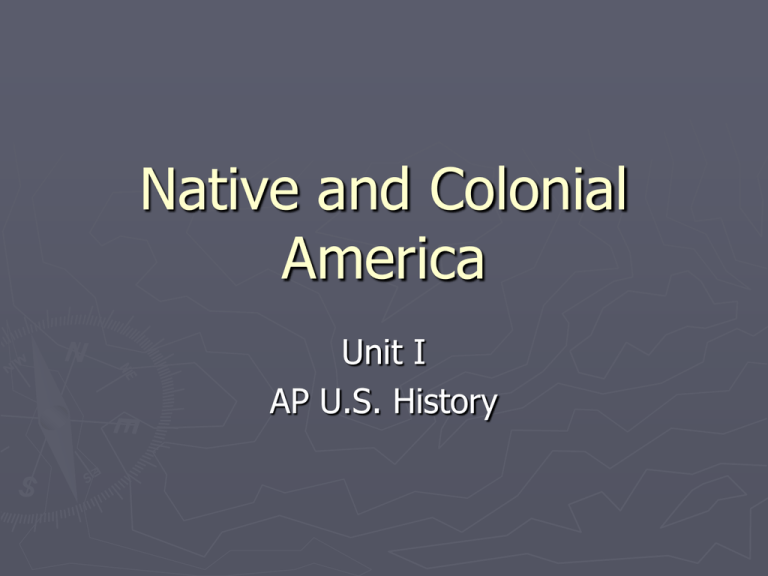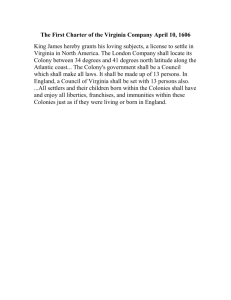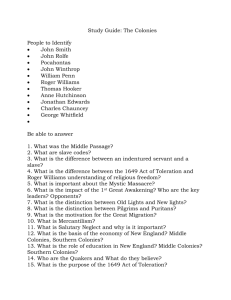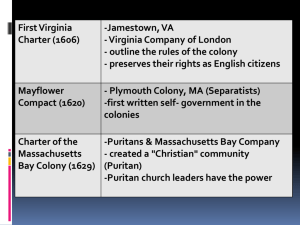Native and Colonial America
advertisement

Native and Colonial America Unit I AP U.S. History Bering Sea Land Bridge Migration Natives ► Nomads ► Agriculturally-based (maize/corn) ► Hopewells/Mississippian Moundbuilders ► Iroquois Iroquois Confederacy Native Map of North America Europe ► Renaissance (rebirth) ► Growth of Nation-States (England, France, Spain, Portugal) ► Protestant Reformation and Religious Wars Counter-Reformation Lutheranism Calvinism Church of England England ► Defeat of Spanish Armada in 1588 makes England a superior naval power ► Population increases ► Joint-stock companies develop ► Religious conflicts divide the nation ► Weak monarchs, civil wars, and revolutions European Colonization ► Columbus in 1492 spearheads European intervention into America ► Relations with natives ► Encomienda system and asiento system Smallpox Columbian Exchange Treaty of Tordesillas European Colonies English Colonies ► Charters ► Corporate Colony Granted a charter to stockholders Ex. Virginia ► Proprietary Colony Granted a charter to individual or group Ex. Maryland, Pennsylvania ► Royal Colony Under direct control of the monarch Ex. New Hampshire Eventually, 8 of the 13 colonies became royal colonies, including Virginia and Massachusetts The First English Colonies ► First Attempt: Roanoke in 1585 ► First Permanent: Jamestown, Virginia in 1607 John Smith – “he that will not work shall not eat” John Rolfe - tobacco Who is this? Oh yeah…Pocahontas Disney’s John Smith Hollywood’s John Smith This is John Smith. Pilgrims ► Separatists to Holland then head for Virginia ► Mayflower takes Separatists and others to Jamestown but weather complicates matters ► Settlers decide to remain and establish Plymouth Mayflower Compact The Mayflower (II) Look, a big rock. Wampanoag Dwelling Plymouth Colony Pulpit/Religion Thirteen Colonies New England ► Massachusetts Bay Colony and Puritans (1630) ► John Winthrop and “city upon a hill” ► Providence, Rhode Island, and Roger Williams (1636) ► Portsmouth and Anne Hutchinson (1638) ► Hartford, New Haven, Connecticut, and Thomas Hooker (1636-1637) ► New Hampshire (1679) New England Culture ► Massachusetts under strict Puritanical lifestyle ► Salem Witch Trials (1692-1693) ► Religious toleration and dissent lead to Rhode Island ► Halfway Covenant: attempt to increase members ► Education by mothers ► Towns with over 50 families required primary schools; 100, grammar schools New England Politics ► Fundamental Orders of Connecticut (1639) ► New England Confederation (1643-1648) ► King Philip’s (Metacom) War (1675-1676) Middle Colonies ► New Amsterdam transferred to Duke of York in 1664 to become New York ► Lands taken from New York to establish New Jersey by 1702 ► Develop wheat and corn farms and eventually into manufacturing and trade ► Delaware created by Pennsylvania (1702) ► Education by private or churches Pennsylvania ► William Penn establishes Quaker-based colony in Pennsylvania (1681) ► Religious Society of Friends aka Quakers ► Holy Experiment Religious refuge Liberal political ideals Economic success Frame of Government and Charter of Liberties Southern Colonies ► Maryland (1632) ► Virginia (1609) ► Carolinas (1663) North Carolina (1729) South Carolina (1729) ► Georgia (1732) ► Limited education due to agricultural base Virginia ► Becomes royal colony in 1624 ► Bacon’s Rebellion (1676) Inequities between large landowners and western farmers Nathanial Bacon vs. William Berkeley ► Headright System 50 acres to each paying immigrant or plantation owner who paid for immigrant Maryland ► Lord Baltimore establishes colony for Catholics ► Act of Toleration (1649) Toleration of all Christian sects Death to those who denied Jesus ► Religious civil war brought control to Protestants Carolinas ► North Carolina Tobacco plantations Well-established autonomy ► South Carolina Rice plantations Became heavily dependent on slavery Georgia ► James Oglethorpe establishes in 1732 ► Defensive buffer to Spanish Florida ► Debtors colony Colonial Religion ► Diverse among colonies regarding strict adherence and religious toleration ► Domination by Protestants; little influence of Anglican Church; other sects and denominations viewed as bizarre ► The Great Awakening (1730s-1740s) Over time, economics became prominent over religious conviction Jonathan Edwards and “Sinners in the Hands of an Angry God” George Whitefield Development of evangelism and individual faith Colonial Culture/Society Rural - Becoming American Urban - Pragmatism - Folkways Typical Colony Layout Immigration ► 250,000 in 1701 to 2.5 million in 1775 ► Europeans and Africans along with a high birth rate ► Reasons: religion; economics; political turmoil ► English, Germans (Pennsylvania Dutch), Scottish, Irish, Dutch, Swedish OLD IMMIGRANTS ► Africans forced to America; suffered discrimination and slave labor Slavery ► Indentured servitude ► Labor shortages lead to importing slaves ► Cheap labor ► Dependable work force ► Slave laws Slave Demographics Mercantilism and Triangle Trade ► Colonies for the Mother Country ► Acts of Navigation Trade on English ships Imports pass English ports Exports to England ► Triangular Trade Middle Passage Colonial Economics ► Land was “gold” ► No established monetary ► Transportation system (gold and silver) Rivers and coasts Horse and carriage led to taverns and postal services ► New England Limited land led to shipbuilding, fishing, trading ► Middle Colonies Wheat and corn fields; manufacturing and trade ► Southern Colonies Tobacco, rice, indigo plantations based on forced labor


